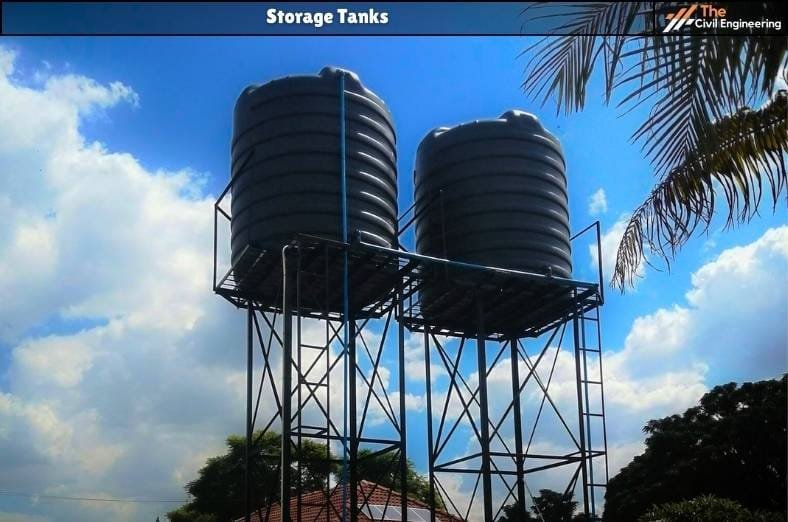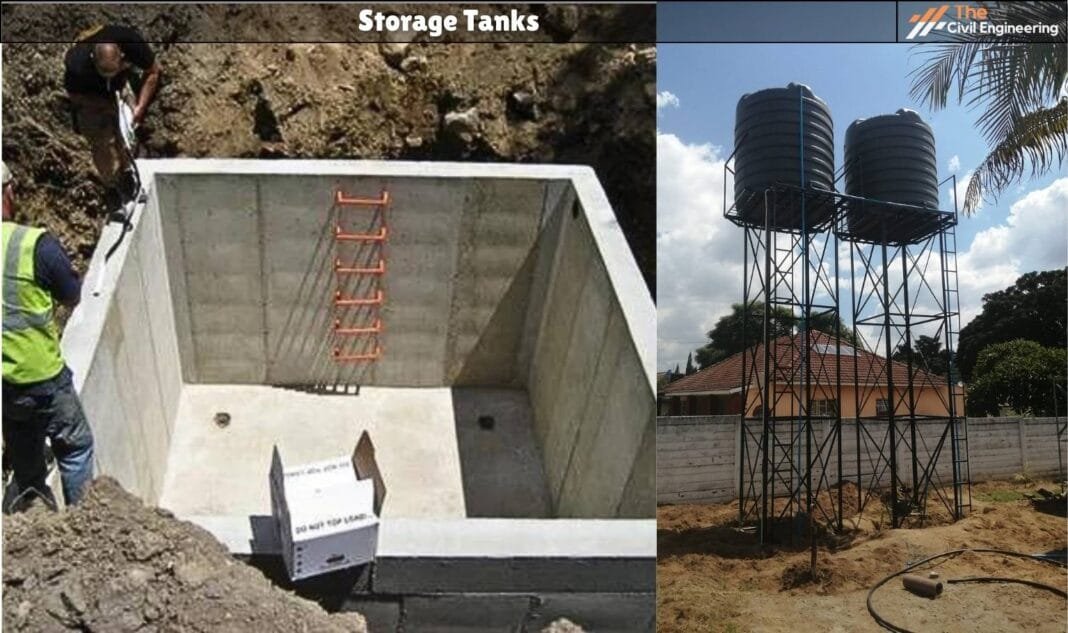In this article, we will discuss storage tanks.
1. Introduction
The water supply to a building may either be continuous or intermittent. Even, in the case of a continuous supply in the mains, the pressure of the water may not be sufficient to rise to all the floors of the building. In either case, storage tanks are required.
The storage tanks may be situated either at a ground level or at the roof level or at both levels. If the pressure of water is sufficient to rise to the roof level, the storage tank is provided only at the roof level, so as to store water because of intermittent supplies.
If the pressure of water is not sufficient, water is first stored at the ground tank from it is pumped to the top storage tank.

2. Materials
A storage tank is made of the following materials:
(i) Mild steel pressed plates
(ii) Reinforced concrete, or
(iii) Stone or brick masonry.
3. Accessories
A storage tank consists of the following accessories :
1. Top cover made of mild steel, aluminum, or other suitable material, light in weight, and tight-fitting so that mosquitoes do not enter. It may have a locking arrangement.
2. Ball valve with a float which is provided near the inlet to the tank, so as to control the inflow of water. The float assembly works automatically, thus maintaining a constant water level in the tank.
When the water level falls down, the float moves down thus opening the inlet valve. When the level in the tank reaches the desired full supply level (F.S.L.), the float rises up thus closing the inlet valve.
3. Overflow pipe which is set about 2.5 cm above F.S.L. In case the float assembly fails, the inflow is not cut off and the water entering the tank overflows through this pipe.
4. Supply pipe or inlet pipe, admitting water into the tank.
5. Outlet pipe with stop valve set about 2.5 to 5 cm above the bottom of the tank, for cutting off the supply to down tank pipes.
6. Drain pipe or scour pipe for cleaning the tank periodically. The capacity of the storage tank depends upon the following factors:
(i) Supply hours from the mains, with sufficient pressure.
(ii) Frequency with which the tank can be refilled during 2.1 hours.
(iii) Rate and regularity of supply.
In the case of multi-storeyed buildings, the first two or three stories may be fed directly from the water mains while upper stories are fed directly from the storage tanks. However, if the supply is either intermittent or irregular, storage may be provided for all the stories.
4. Flushing storage Tank
These tanks are required to supply water to the various flushing cisterns through down tank pipes. The supply pipes of a building do not directly feed water to these cisterns. The storage capacities for flushing purposes depend upon the number of water closets (W.C.) and urinals in a building.
5. Use of Storage Tanks
1. It is used to provide storage volume.
2. It is used to provide pressure to the distribution system.
| Read Also: Water Supply Engineering |
6. Advantages of Storage Tanks
1. It protects water from evaporation.
2. It does not provide breeding grounds for mosquitos, like stagnant water in lakes and ponds.
3. It helps to protect water from contamination by animal and human waste.
7. Disadvantages of Storage Tanks
1. Regular maintenance is required.
2. It can be very expensive during maintenance.
3. Drinking water collecting over a long period can cause serious health issues.
| Read Also: Water Carriage System |
| Read Also: Partition Wall |

